
Reading a Compass
General Directions
A compass can be used in many ways, from telling which way is North to finding hidden treasure or following an unmarked path over wilderness terrain. But, you've got to take baby steps, so let's talk about how the a compass is laid out.

There are four cardinal points on a compass - North, South, East, and West. When reading a compass, and telling other people directions, you need to wipe "right" and "left" out of your vocabulary. Right and Left are relative directions and differ depending on your location and direction, but the cardinal points are constant.
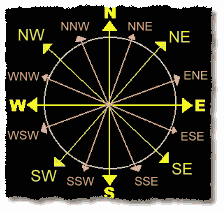
The direction halfway between North and East is an intercardinal point and is called NorthEast. The other three intercardinal points are SouthEast, SouthWest, and NorthWest.
Finally, there are secondary intercardinal points halfway between each cardinal point and intercardinal point. These are North-NorthEast, East-NorthEast, East-SouthEast, South-SouthEast, ... and so on. With these directions, you can give someone a fairly good idea of what direction they need to go. We could add additional points, continueing to break each section in half over and over, but telling someone to go East-EastEastNorthEast-EastNorthEast would not be fun.
Since there IS a need for more precise directions, the circle of a compass face is split into 360 marks called degrees. For rough directions, go ahead and use North or NorthWest. But, for finding your way or locating destinations in the wild, use degrees as you'll see in a bit.
Two Types of Compasses
We will be discussing the mountaineering compass, also called the orienteering compass. This is the type that has a needle that always points north and you need to move a dial to find directions.
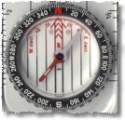
You've seen compasses in cars or toy compasses - neither of these have a noticable needle and are called "Card Compasses". Actually, there is a magnetic piece like a needle, but it has a paper disk (card) glued to it or has a plastic ball around it that is free to rotate. As the vehicle turns, the card (or ball) remains fixed so the part you see changes. These are fine for general directions, but not helpful for what we want to do.

Basic Compass Reading
No matter the compass, one end of the needle always points North. On our mountaineering compasses, it is almost always the RED end, but its a good idea to test your compass before starting to use it.
If you are north of the equator, stand facing the sun around lunchtime with your compass resting in your hand in front of you. Whichever end of the needle points towards the sun is South and the end that points at you is North.
If you're 'down under' the North end points towards the sun and the South end points at you.
Become familiar with Parts of the Compass before learning to read your compass.
To read your compass,
- Hold your compass steadily in your hand so the baseplate is level and the direction-of-travel arrow is pointing straight away from you.
- Hold it about halfway between your face and waist in a comfortable arm position with your elbow bent and compass held close to your stomache.
- Look down at the compass and see where the needle points.
This compass is pointing due North (also 0 degrees) 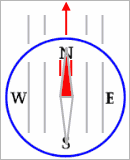
- Turn your body while keeping the compass in front of you.
- Notice that as the compass rotates, the needle stays pointing the same direction.
- Keep turning until the needle points to East on the compass like the picture below, keeping the direction-of-travel arrow and North mark facing straight in front of you.
The needle on this compass is pointing East (90 degrees) 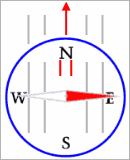
- Important: This is a very common mistake! The compass needle is pointing towards East so I must be pointing East, right? No, no, no!
To find my direction, I must turn the compass dial until the North mark and the "Orienting Arrow" are lined up with the North end of the needle. Then I can read the heading that is at the Index Pointer spot (the butt of the direction-of-travel arrow).
Since the Orienting Arrow is usually two parallel lines on the floor of the compass housing, a good thing to memorize is:RED IN THE SHED Now we know we are really heading West (270 degrees) 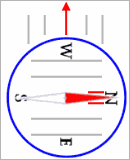
Take a Bearing
By simply moving your compass with your body and using the N-E-S-W markings, you can get a good idea which way you are going. This is often all you need from your compass. But, you've probably noticed on your compass, there are also numbers and tiny lines. These represent the 360 degrees in a circle that surrounds you no matter where you are.
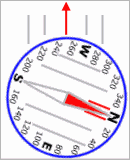
When you need to find your way from one particular place to another, you need to use these numbers to find out the bearing to that remote place. The direction you are going is called your heading. Heading and Bearing are pretty much the same thing. The image above is a heading of about 250 degrees.
Using your compass, take a few bearings. Move your body until the direction-of-travel arrow points at the following items and then turn the dial until "RED is in the Shed". Then, read the bearing at the Index Pointer:
- You computer screen: ____________ degrees
- Your window: ____________ degrees
- Your door: ____________ degrees
- A lightswitch: ____________ degrees
Compass Reading Tips
- Hold the compass level - if the compass is tilted, the needle will touch the clear lid and not move correctly.
- Read the correct end of the needle.
- Use common sense, such as knowing that if you are in North America, Europe, or Asia and heading anywhere towards the sun during the middle of the day, you are heading in a southerly direction. If you are south of the equator and heading towards the sun, it's just the opposite and you are heading in a northerly direction. (If you are in the tropics, between the Tropic of Cancer at 23.5 degrees North of the equator and the Tropic of Capricorn at 23.5 degrees South of the equator, then this tip should not be used. The sun can be either north or south of you, depending on the time of year.)
- RED IN THE SHED!
- Keep the compass away from metal objects - even a knife, flashlight, or keychain can cause a false reading if too close to the compass.
 Radio conversation between two ships passing in the night...
Radio conversation between two ships passing in the night...Voice 1: "We can see your lights and you are on a collision course with our vessel. Please divert your course 15 degrees to the North to avoid a collision." Voice 2: "I can see your lights too and recommend you divert your course 15 degrees to the South to avoid a collision." Voice 1: "This is the captain of a US Navy ship. I say again, divert YOUR course." Voice 2: "No, I say again, you divert YOUR course." Voice 1: "I am in the U.S.S. Wolverine, the largest battleship on this ocean. I DEMAND that you change your course one-five degrees North!" Voice 2: "I am in the Point Amour lighthouse. Your call, sir." |
| Search Google News for more 'Lost Hiker' news items. |
| 08 Dec 2025 - Hiker who set out to climb Mount Whitney for 21st birthday missing 3 weeks later |
| 30 Oct 2025 - Returning to the Appalachian Trail After the Murder That Changed It |
| 05 Dec 2025 - Mount Whitney hiker missing for 3 weeks feared dead |
| 04 Dec 2025 - Sitka Search and Rescue assists lost hiker in early hours of the morning |
| 17 Nov 2025 - Old Hiker Missing From Appalachian Trail Intensifies |
| 24 Nov 2025 - Lost Hikers on Mt. Monadnock in Jaffrey |
Comments:
Sep 24, 2015 - joan schoepf
Thanks!
I am having trouble with my Compass when I point it at my car as my home point and go out in the woods when I am ready to go back to the car from a day in the woods I look at the point where I started from and start to head back but I always come back way off and some time I go past my home point and if I keep going it could go on for ever what am I doing wrong
like today I turned around to get my reading on the car and it was South 37 and went out for the day and when it was time to head home back to the car and I was turning to get back to South 37 it took me past the car and thank God it was on a road and I just walk a way and got back
Will you agree that as long as I keep the needle on N that for all practical purposes I can indeed follow the equator all around the world (assuming you could walk on water of course!)
You would need to adjust for the declination as you traveled.
The reason your reading of the car was off was because when you took your reading to the car at South 37 and then moved again the line from your car to the last reading and where you were later on was not in a straight line. Pick a point and take a reading to that point then go to another point but you have to take another reading.
My wife is learning to fly. Her instructor may say, turn onto a heading of ( he gives a heading, lets say 270 degrees). She sees the compass says her heading is 45 degrees. She wants an easy way to know whether to turn right or left. Obviously one way is shorter to get onto the new heading. She has always had difficulty in reading the time . Any ideas?
Gave the rest to my nephews Compass dude thanks again
Ask a Question
More Map and Compass Resources at CompassDude.com



Recent Comments